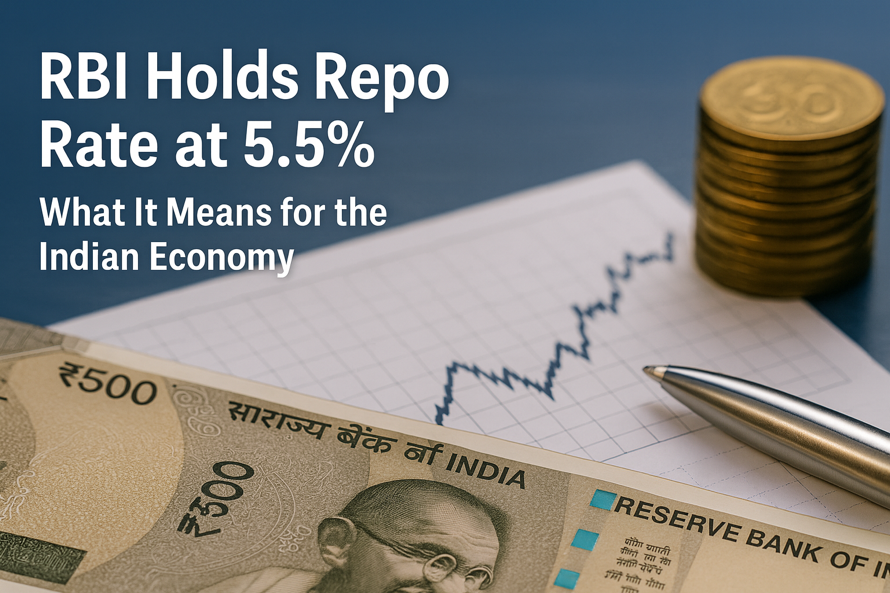
India’s Interest Rate Hits Pause: What You Need to Know
In its August 2025 review, the Reserve Bank of India (RBI) chose to hold the repo rate steady at 5.5%, marking a pause after cutting rates by a full percentage point earlier this year. With inflation cooling and growth holding steady, this “wait-and-watch” move is aimed at giving earlier cuts more time to work their way through the economy.
So, what does this mean for your loans, investments, and India’s economic outlook? Let’s break it down.
Why the RBI Hit Pause
The RBI’s Monetary Policy Committee (MPC) decided unanimously to keep policy rates unchanged. The central bank wants to see the full impact of earlier rate cuts—which lowered borrowing costs by 100 basis points between February and June—before making new moves.
This cautious stance reflects a mix of domestic confidence and global caution. While India’s internal economy shows strength, rising global trade tensions—especially from U.S. tariff threats—could still throw surprises.
Growth Looks Solid, But RBI Wants More
The RBI kept its GDP growth forecast for 2025–26 at 6.5%, supported by:
- Strong rural demand and steady consumption
- Increased government infrastructure spending
- Favorable monsoon and good crop sowing
- Momentum in construction and services sectors
Still, Governor Sanjay Malhotra noted this is “below our aspirations”, hinting at a long-term target closer to 7%. This leaves the door open for more support if needed.
Inflation Is Cooling Off—Fast
One of the biggest positives: inflation is under control. The RBI revised its CPI inflation forecast down to 3.1% for FY26, thanks to:
- A sharp fall in food prices (food inflation went negative in June)
- Healthy monsoons supporting crop yields
- Large buffer stocks of food grains
Retail inflation hit a 77-month low of 2.1% in June 2025—a strong signal that price pressures are easing.
However, the RBI expects inflation to creep back up in early FY27 as the favorable base effect wears off.
What This Means for Borrowers and Lenders
If you’ve taken a home loan or personal loan with a floating rate, this policy is good news. While there’s no new cut, banks are still passing on previous reductions, so your EMIs may go down over time.
For banks and lenders, the stable rate environment means more clarity to plan lending and deposits, and a chance to align fully with the new rate regime.
How the Markets Reacted
Markets had a muted reaction, with stocks dipping slightly. But analysts mostly saw this as a “dovish pause”—a sign that while the RBI is holding steady for now, it’s still focused on growth and may cut rates again if needed.
Sectors like real estate, manufacturing, and infrastructure are expected to benefit from strong liquidity and stable borrowing costs.
RBI’s Bigger Strategy: Liquidity + Patience
Besides rate cuts, the RBI also reduced the Cash Reserve Ratio (CRR) by 100 bps to 3% earlier this year, releasing ₹2.5 lakh crore into the banking system. This helped ensure there’s plenty of credit available to businesses and consumers.
The RBI continues to keep liquidity comfortably in surplus, making sure that rate cuts actually reach the end user and support real economic activity.
Global Risks Still Loom
The elephant in the room? Global trade tensions, especially the possibility of new U.S. tariffs on Indian goods. While the RBI doesn’t expect a major hit to inflation from these policies, it’s keeping a close eye on the situation.
India’s inflation is less vulnerable to global price shocks because a large share comes from food and non-tradables. But if retaliatory tariffs happen, things could change quickly.
What’s Next?
The RBI’s next policy meeting is set for late September to early October. Between now and then, decisions will depend on:
- How inflation trends evolve
- Global trade developments
- Whether economic growth needs more support
If inflation stays low and growth falters, another rate cut is possible. But for now, the RBI is choosing patience over haste.
Key Takeaways
- Repo rate held at 5.5% to let earlier cuts take full effect
- GDP growth forecast steady at 6.5% for FY26
- Inflation forecast lowered to 3.1% amid falling food prices
- Borrowers may still see lower EMIs as banks pass on past cuts
- RBI remains flexible, watching data closely for next moves
FAQs
Q. Will home loan EMIs go down?
Possibly, yes. Banks are still adjusting their lending rates based on earlier repo cuts. Your EMI could reduce over the next few months.
Q. Why didn’t the RBI cut rates again?
The central bank wants to see how the last 100 basis points of cuts play out before making more moves.
Q. Are global factors like US tariffs a concern?
Yes, but for now, the RBI doesn’t expect a big inflation impact unless things escalate into a full trade war.




